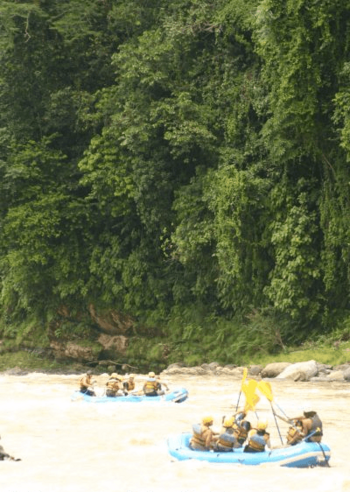Pacuare River facts for kids
Quick facts for kids Pacuare |
|
|---|---|

Pacuare River
|
|
| Country | Costa Rica |
| City | Siquirres |
| Physical characteristics | |
| Main source | Talamanca, Costa Rica |
| River mouth | Caribbean Sea, Costa Rica |
| Length | 129 km (80 mi) |
The Pacuare River, also called the Río Pacuare, is a famous river in Costa Rica. It starts high up in the Cordillera de Talamanca mountains. From there, it flows about 108 kilometres (67 mi) until it reaches the Caribbean Sea.
This river is super popular for exciting water sports. People love to go white water rafting, whitewater kayaking, and riverboarding here. The thick rainforests around the river are full of amazing animals. You might spot jaguars, monkeys, ocelots, and many different kinds of birds. Many people think it's one of the top five rivers in the world for rafting!
For a while, there was a plan to build a hydroelectric dam on the Pacuare River. This idea came from Costa Rica's state electricity company in 1986. But in 2005, the plan was stopped. People were worried about how it would affect the river's nature and the fun activities like rafting.
Contents
Exploring the Pacuare River Sections
The Pacuare River is split into about sixteen different parts. The three most common sections that people explore are known as The Upper Upper, The Upper, and The Lower. Each section offers a different kind of adventure!
The Upper Upper Section: Rapids and Fun
This part of the river is about 16 miles (26 km) long. It has many rapids that are rated from Class II to Class IV. This means some parts are easy, and some are quite challenging! It's a popular section for both rafting and kayaking. Getting to the start of this section needs careful planning.
The Upper Section: Technical Challenges
This section is about ten miles long and is more difficult. It has many Class IV and V rapids, which are very tough and exciting! There are also some waterfalls along the way. The journey ends at a place called Finca La Cruz. This part is usually explored by experienced kayakers using special "creeking style" kayaks.
The Lower Section: Famous Adventures
This is the most well-known part of the Pacuare River. It has Class III and IV rapids, offering a great mix of excitement. This section stretches about 23 miles (37 km) from Finca La Cruz to the town of Siquirres. Along the way, the river drops about 1,200 feet (370 m).
You can enjoy this trip in one long day or spread it out over three days. Some of the most exciting spots include the rapids and waterfalls in the Huacas River Gorge. Famous rapids here are Upper and Lower Huacas (Class IV), Double Drop (Class III), and Cimarones (Class IV). There are also many huge waterfalls that are known worldwide.
History of Rafting on the Pacuare River

The first time anyone is known to have run the Pacuare River was in the winter of 1980-1981. A group of kayakers from Poland explored it while traveling through Central America.
The very first rafting trip happened in February 1981. The group included Nick Hershenow, Sharon Hester, Jerry Kaufman from the USA, and Rudy Koller from Canada. Sharon and Nick were rafting guides. They used a 3.7 metres (12 ft) raft, and Rudy mostly kayaked. Their trip took 5 days, starting at a bridge and ending at a railroad. From there, they flagged down a train back to San Jose.
In 1978, Michael Kaye started a company called Costa Rica Expeditions. They began offering commercial rafting trips on the Pacuare River in the winter of 1981-1982. Later, between 1980 and 1983, Rafael Gallo, who used to work for Kaye, started his own company called Rios Tropicales. Aventuras Naturales also began offering trips in the mid-1980s. In 1986, Tico's River Adventures started in Turrialba, a city close to the river.
In 1998, a dam was built on the nearby Reventazon River. This caused many rafting companies and people to focus more on the Pacuare River for their adventures.
Amazing Plants and Animals of the Pacuare
The area around the Pacuare River is home to many incredible animals. Large cats like jaguars have been seen, especially near the Huacas River Gorge. These animals are shy and hard to spot. In 1986, a black panther was seen about 2 kilometres (1.2 mi) from the river.
You can also find anteaters, raccoons, river otters, iguanas, capuchin monkeys, and sloths. Howler monkeys are often heard and seen in the lower sections of the river, especially after the Dos Montanas canyon.
There are five common types of snakes in this area. Some are venomous, like the coral snake, the bushmaster, and the fer-de-lance. There are also non-venomous snakes like the "laura" and "sopy lota," which are long black snakes known to eat venomous snakes.
The beautiful blue morpho is the most popular butterfly you'll see here.
Many different birds live along the river. The chestnut-mandibled toucan is often seen when it's raining or foggy. You might spot parakeets after the Dos Montanas canyon. Other common birds include the oropendula (a type of oriole), kingfishers, tiger and blue herons, hawks, osprey, king vultures, sunbitterns, and snowy egrets.
Most of the land along the river is untouched rainforest. Common trees include the ceiba tree, which is the national tree of Guatemala. You can also see the red Indio desnudo, also known as the "naked Indian tree" (naked Indian tree).
After the Dos Montanas area, you'll see many heart of palm trees, coconut palms, and banana trees.
See also
 In Spanish: Río Pacuare para niños
In Spanish: Río Pacuare para niños

